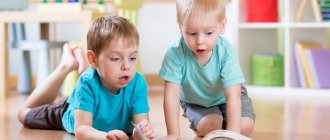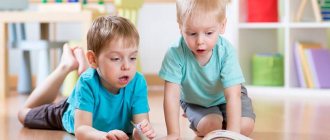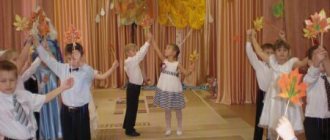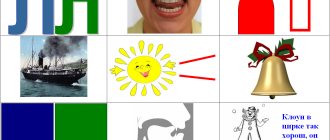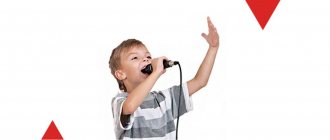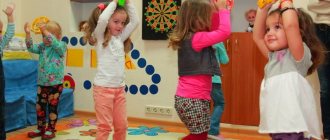Purity of speech affects future success at school and the process of social adaptation. Logorhythmics for children 2-3 years old is recognized throughout the world as a universal method for improving speech skills.
Logorhythmics is based on a set of exercises to improve articulation and breathing, physical fitness, and sense of rhythm. As a result of classes, both the ability to navigate the huge world around us and the understanding of the meaning and order of completing the proposed tasks increase. The little person begins to show himself as a creative person.
What is this
Volkova G.A., Shashkina G.R., Ekaterina Zheleznova studied the positive impact of rhythmic movements on speech together with the pronunciation of words and correct breathing in Russia. From their point of view, logorhythmics is a complex system of motor exercises aimed at eliminating speech anomalies in preschoolers and developing motor skills.
V.A. Gilyarovsky and N.A. Vlasova defined what logorhythmics is differently. In the mid-20th century, they studied the causes and methods of correcting logoneuroses. The main attention was paid to the word as a way to solve speech disorders. Rhythm and movement were given a secondary role. But they noted the usefulness of speech therapy rhythms for intellectual and aesthetic development.
In other words, logorhythmics is an activity that includes marching to rhythmic music, walking to a count, and running. Simultaneously with physical activity, the task is to control breathing, pronounce phrases, sing in a certain intonation, loudly or quietly, etc. Classes are held in an entertaining format, in a group or individually.
What is logorhythmics?
Logorhythmics is a method of active correctional pedagogy, the action of which occurs due to the combination of three elements - movement, music and speech (word/sound).
Is this method right for you?
Of course, correctional classes are designed for children with certain problems. Logorhythmics is suitable for children who have encountered difficulties such as:
1. Delayed speech development
2. Problems with articulation, pronunciation and speech rate
3. Poor coordination of movements, insufficient development of fine and gross motor skills
4. Stuttering
These are the main indications for practicing speech therapy rhythms. Of course, logorhythmics has not only medical indications, although it is designed to solve the above problems, it is an excellent pedagogical way for the learning and all-round development of a child.
It is possible that many mothers unknowingly use some techniques at home, thereby not only diversifying their child’s leisure time, but also providing a full-fledged lesson.
Goals and objectives
The main goal of speech therapy rhythm for preschoolers is the correction and prevention of speech disorders by improving motor skills. Logorhythmics also has other related goals - health improvement, physical and spiritual education.
A lesson with elements of logorhythmics poses the following tasks for the teacher:
- Breathing development
- Correction of speech disorders
- Training in control of movements, speech, functioning of the organs of articulation and breathing
- Improving coordination
- Development of all types of memory, attention, spatial orientation
- Cultivating a sense of rhythm
- Reinforcing spatial concepts
- Introduction to spiritual values (music)
- Learning to sing and pronounce tongue twisters
- Expanding your horizons
- Increasing vocabulary
We develop speech, voice, memory using proven logorhythmic methods.
Contained in sections:
- The work of a speech therapist. Speech therapy 8270
By groups:
- Senior group
- Preparatory group
- Middle group
- Junior group
Showing publications 1-10 of 1456. All sections | Logorhythmics. Logorhythmic exercises
New
Photo
The best
Notes for a logorhythmics lesson in a senior speech therapy group “Hello, autumn, hello, forest full of fairy tales and miracles.” Notes for a logorhythmics lesson in a senior speech therapy group . Topic: “Hello, autumn, hello, forest full of fairy tales and miracles!”
Objectives: 1. Development of spatial orientation. 2. Development of coordination of speech with movement. 3. Development and activation of attention. 4. Development...
Elements of speech therapy rhythms in music classes as a means of developing general motor skills Music is one of the brightest and most emotional forms of art, the most effective and efficient means of raising children. It helps to more fully reveal the child’s abilities, develop hearing and sense of rhythm, and teach him to correctly perceive the language of musical images. Introducing kids to...
Complexes for children 2-3 years old
Logorhythmics for kids involves the creation of special sets of exercises and entertaining activities. Games and exercises are performed using the method of imitation.
Animals
- Helps to get acquainted with the world of animals, insects, birds. Classes involve reading poetry, imitating walking movements, and animal sounds.
- Kids can walk like a bear, flap their wings like a swan, a sparrow, walk like a duck, etc.
- Onomatopoeia is required. The teacher asks: “How does a goose scream when it flies?” Pupils should wave their arms and answer: “HA-HA!”
- Pictures of animals and birds are used to help the speech therapist, teacher and parents.
- You can use the story with the bear and the cone:
The clumsy bear walks through the forest, collects cones and puts them in his pocket...
Children walk with their teacher, roar like a bear, and collect pine cones.
Vegetables and fruits
- They expand their knowledge of the world around them, the colors of fruits, and introduce them to their names.
- The following exercises are used for the lesson:
Salt the cabbage. The poem is read:
We cut the cabbage, cut it, We chop the cabbage, chop it...
Children make movements with their hands, pretending to be a knife or a hatchet.
We salt the cabbage, salt it, We press the cabbage, press it.
And we'll grate the carrots.
They depict how they stir, salt, and squeeze chopped vegetables.
- Let's go to the garden
Pictures depicting garden vegetables and garden fruits are used. First, you should have a conversation, tell preschoolers about where vegetables and fruits grow, what color they are, how they smell, etc.
Then a scene of a trip to the garden to collect the harvest is depicted. You can use fruit toys that the children will pick from trees and collect from beds. A competition game is suitable: children are divided into 2 teams, toy fruits are laid out around the room. The teacher asks each team to find as many fruits from one group as possible: for example, vegetables. Children take turns looking for them and bringing them to their basket.
Progress of the lesson:
Speech therapist : (there is a knock)
-I’ll see who’s knocking on our door now. Shows a doll .
-Who is this?
Children: doll .
Doll : My name is Tanya .
Speech therapist : Invites the children to shake hands with Tanya and say their name.
Speech therapist : Doll Tanya loves to play
- Do you love it?
Children:…
Speech therapist : now, the Tanya doll will perform movements, and you will guess and name what the doll . I'm starting" (show)
4. Listening. Game moment “Wake up Tanya”
.
(Lullaby “Bayubayu”
music
M. Kraseva, lyrics. M. Charnoy “Oh, you canopy”
b. n. P)
Tasks: teach, listen carefully to a lullaby and song; react emotionally to the affectionate, melodious and playful nature of the music; understand the content; actively participate in the game action.
Complex for children 3-4 years old
Logorhythmics in kindergarten for children over 3 years old may include the following complexes:
- Finger gymnastics
You need to stretch the fingers of both hands, make locks, depict boats, household items, etc. At the same time, poems are recited on various topics:
- Who sings what?
The cat sings a song: Meow! Meow! (children petting an imaginary cat).
The clock sings: Tick! So! (the handles represent ticking arrows).
Piglet grunts: Oink! Oink! (fingers make a patch - a circle).
The cabin in the river does not sing: Mmmmm! Mmmm! (press their lips, cover their mouth with their hands), etc.
- Mushrooms
Children stand in a row and walk through the forest to look for mushrooms. Massage your fingers without ceasing to walk. The teacher counts, creating a rhythm.
Top-top - five steps (children step to the rhythm of the poem), And in the basket there are five mushrooms (we count the fingers on the hands), Amanita is red (we stretch the index finger), It is very dangerous. And the second is a fox (we touch the next finger), a red pigtail. Pink ear (touch the ears) The third mushroom is the trumpet mushroom. And the fourth mushroom is the morel (tugging at the ring finger), a bearded old man. Well, what is the fifth mushroom? White! (put your hands in a lock and play with your fingers).
- Singing
Music lessons are used. Children learn breathing exercises. It is not necessary to sing songs; you can hum individual sounds, imitate animals, while doing physical exercises at the same time.
- Outdoor games to music
Logorhythmic exercises are performed with musical accompaniment. Words and movements are learned, attention and memory develop. You can use balls, passing them around to each other in a circle, chairs, toys to hide and quickly find, etc. Logorhythmics tasks for children 3-4 years old can be slightly complicated and used for games with the older, preparatory group.
Progress of the lesson:
Music director: “ Tanya is tired and wants to sleep. Tanya will sleep , and we will sing Tanya a lullaby."
Speech therapist : (rocks the doll )
.
Music of hands: (performs a song)
.
Next, he invites the children to clap their hands to wake up Tanya. Tanya doesn't wake up . We stomp our feet. Tanya wakes up .
Music director: “ Tanya is rested and wants to go for a walk, to cheerful music ( the doll is “dancing”
in the hands
of a speech therapist ).
5. Rhythmic game “Walking with a doll ”
Objectives: to teach children to distinguish between the rhythm of walking and running; to convey it by slapping the palms of the hands on the knees: slowly and quickly (first as shown by an adult , then by pronouncing words and performing movements.
Complex for children 5-6 years old
- Movement exercises It is better if the children themselves come up with movements to the poem that the teacher reads:
We will go to the forest today (children are walking), Who climbed the tree? (raise their heads up) Cuckoo? Cuckoo? (put hands to lips, repeat words) I’ll find you anyway
- Physical warm-up
Physical education to music. The poetic form of commands is used. Children gradually learn it by heart and pronounce it themselves.
The mouse ran quickly (we move one after another, slowly), The mouse wagged its tail (we repeat the movements of the animal), And dropped the egg (tilt down - lift up), Look, oh, it broke (we shake our heads, put our palms to our cheeks).
Logorhythmics in preschool educational institutions is used in any lesson: physical education, speech therapy, music. Teachers should pay attention to the pronunciation of auxiliary poems and words by children, and to the correct breathing of children during exercise.
Progress of the lesson:
Music director “Doll Tanya” loves to stomp her feet and run fast to the music. At first, Tanya’s legs walk slowly, like this: …. (pronounces the words and slowly, rhythmically alternately taps his palms on his knees, and then Tanya’s legs quickly run along the path, like this: (pronounces the words and quickly, rhythmically alternately taps his palms on his knees)
Music The hand invites the children to take a walk with the doll Tanya , and our palms will help us.
with the doll Tanya (2 times,
And then, then, then everyone runs, runs, runs (2 times)
.
6. Game “Hide and seek with a doll ”
.
(Music by G. F. Vikhareva)
Objectives: introduce children to a new game and its rules; develop attention, the ability to move in accordance with the nature of the music, to begin and end movement with the beginning and end of the music; actively engage in the game situation.
Recommendations for conducting classes
- Shape the lesson load according to the age and development level of preschoolers
- Give a lesson in the afternoon
- Change the topic of the lesson every week
- When selecting material, rely on lexical topics
- Use fairy tales and cartoons for speech and music exercises
- Exercise every day
- Accurately and clearly demonstrate to children the movements of their hands, body, and lips during phonation. Monitor the quality of assignments.
To solve your children’s speech problems, you don’t have to wait for help from a preschool education institution; work with your child at home. The logorhythmics technique is easy for any parent to learn.
Author's developments
The author's methods come to the aid of parents and teachers, techniques from which can be used at home and in an organized manner in kindergartens.
E. Zheleznova’s technique is quite well known and widespread. The proposed exercises are performed with pleasure by children; this technique is also good because it is suitable for children under one year old.
Singing and dancing are encouraged during the classes. Short songs help the baby learn to pronounce sounds and words correctly, control breathing, and improve coordination.
Such activities are excellent physical activity for a child. The complex includes massage, finger games, breathing exercises and much more. To conduct classes at home, you will need the musical accompaniment itself, which can be easily purchased, as well as improvised means and toys.
The method of M.Yu. is also widely known. Kartushina. Her manuals present various activities that will help improve coordination, sense of rhythm, and introduce the child to such important concepts as size, shape, color.
During the exercises, fine and gross motor skills are used. Classes can be carried out both in a mobile form and during a calmer activity, for example, drawing. The technique describes different methods of massage and self-massage. You can do breathing exercises at home.
